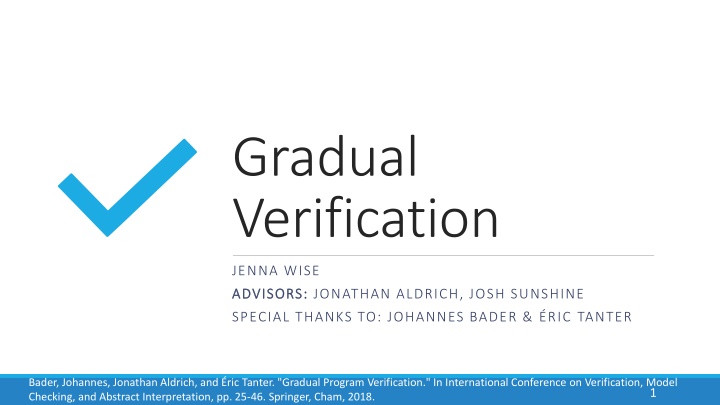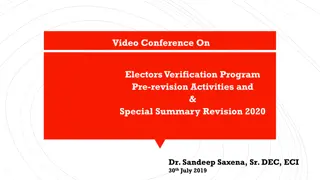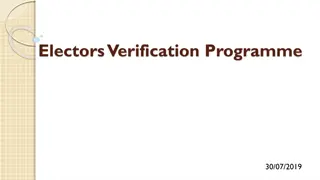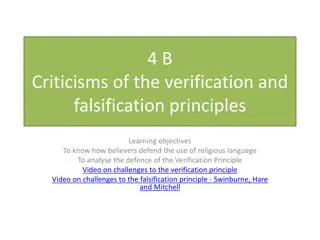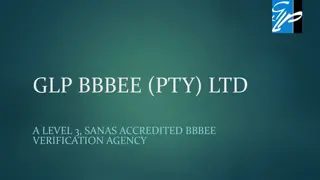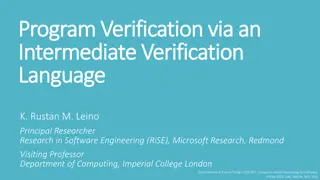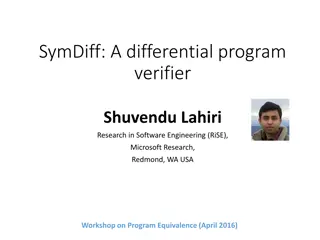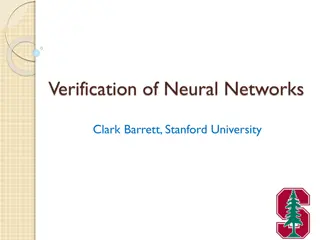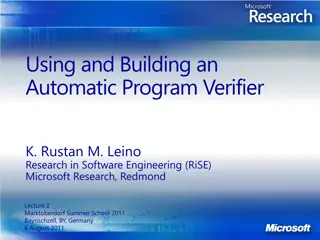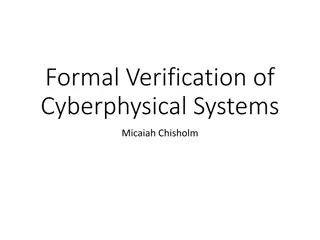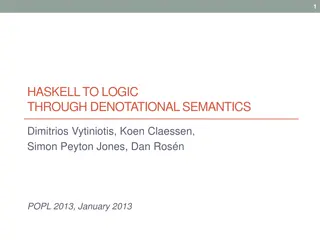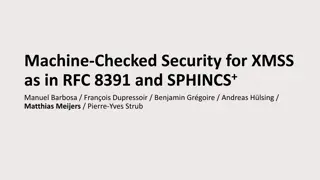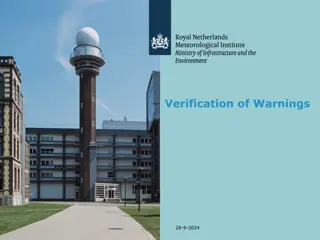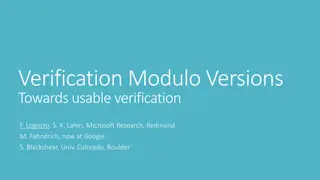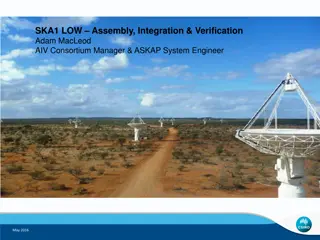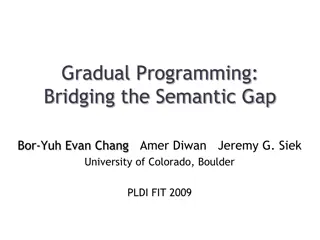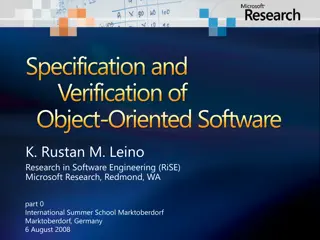Gradual Program Verification and its Techniques
Gradual Program Verification introduces a method where static verification is combined with dynamic verification to ensure program correctness gradually. This approach allows for partial specifications and runtime checks to be gradually applied, reducing the risk of errors and overhead in software development. The technique includes static guarantees, dynamic checks, and gradual formulas to maintain verifiability as specification precision changes.
Download Presentation

Please find below an Image/Link to download the presentation.
The content on the website is provided AS IS for your information and personal use only. It may not be sold, licensed, or shared on other websites without obtaining consent from the author.If you encounter any issues during the download, it is possible that the publisher has removed the file from their server.
You are allowed to download the files provided on this website for personal or commercial use, subject to the condition that they are used lawfully. All files are the property of their respective owners.
The content on the website is provided AS IS for your information and personal use only. It may not be sold, licensed, or shared on other websites without obtaining consent from the author.
E N D
Presentation Transcript
Gradual Verification JENNA WISE ADVISORS: ADVISORS: JONATHAN ALDRICH, JOSH SUNSHINE SPECIAL THANKS TO: JOHANNES BADER & RIC TANTER Bader, Johannes, Jonathan Aldrich, and ric Tanter. "Gradual Program Verification." In International Conference on Verification, Model Checking, and Abstract Interpretation, pp. 25-46. Springer, Cham, 2018. 1
Overview & Motivation Static Verification (at compile time) Dynamic Verification (at runtime) If sound, no static errors means no runtime errors (no extra runtime checks) Software can be partially specified with partial specs Gradual Verification Specs turned into runtime checks (runtime overhead) Software must be fully specified with detailed specs 2
Static Verification by Example Client Program Annotated Function int balance 100; Q: ??????? = 100 P: ??????? 30 balance withdraw(balance, 30); Q: ??????? 0 P: ??????? 40 balance withdraw(balance, 40); int withdraw(int balance, int amount) requires ??????? ?????? ensures ?????? 0 Postcondition: Q Precondition: P ? ? return balance amount; } { 3
Dynamic Verification by Example Client Program Annotated Function int balance 100; assert P: ??????? 30 balance withdraw(balance, 30); assert P: ??????? 40 balance withdraw(balance, 40); int withdraw(int balance, int amount) requires ??????? ?????? ensures ?????? 0 ? assert P: 100 30 ? assert P: 70 40 return balance amount; } { 4
Gradual Guarantee Reducing the precision of specifications never breaks the verifiability of a program (formalized in [1]) static guarantees + dynamic checks Static Verification (at compile time) Dynamic Verification (at runtime) + static guarantees dynamic checks Gradual Verification adhering to Gradual Gaurantee [1] Bader, Johannes, Jonathan Aldrich, and ric Tanter. "Gradual Program Verification." In International Conference on Verification, Model Checking, and Abstract Interpretation, pp. 25-46. Springer, Cham, 2018. 5
Approach 6
Gradual Formulas ? = ? | ? ? Allow imprecision in specifications via the ? wildcard 7
Gradual Formulas Gradual formulas are given meaning by the set of fully precise formulas it represents Gradual Formula Set of Representing formulas ??????? 0 ??????? 0 ??????? = 0, ??????? 0, ??????? 0 ? ??????? 0 ?????? 0 ??????? 0 ??????? < 0 8
Static Verification in Gradual Setting Lifted from normal static verification using ideas from Abstract Interpretation on Gradual Typing [1] Predicates Functions ??? ????,? Static Verification in Gradual Setting Uses lifted predicates and functions [1] Garcia, Ronald, Alison M. Clark, and ric Tanter. "Abstracting gradual typing." ACM SIGPLAN Notices. Vol. 51. No. 1. ACM, 2016. 9
Lifting Diagram ? ? ? ? ? Set of ? Exist ?1 Exist ?2 Set of ? 10
WLP Lifting Diagram ??? ? ?? ? ? ? ??? Set of ? Set of ? 11
Static Verification in Gradual Setting: An Example Client Program Annotated Function int balance 100; Q: ??????? = 100 P: ??????? 30 balance withdraw(balance, 30); Q: ??????? 0 ? P: ??????? 40 balance withdraw(balance, 40); int withdraw(int balance, int amount) requires ??????? ?????? ensures ?????? 0 ? ? ? return balance amount; } { 12
Dynamic Verification in Gradual Setting Dynamic verification in the gradual setting must ensure that a valid instantiation of ? in the static checker is valid at runtime Pay-as-you-go cost model: optimized runtime checks based on statically guaranteed info 0 static guarantees All dynamic checks static guarantees + dynamic checks All static guarantees 0 dynamic checks ?1 ?? 1 ? ?1 ?? 2 ? ?1 ? ? ?1 ?? + static guarantees dynamic checks 13
Current & Future Work Building a usable, language independent, and robust gradual verification tool Supports verification of programs written in multiple languages Java, Wyvern, C0 Supports efficient verification of many different language features Shared mutable state, recursive data structures, loops, etc. 15
Current & Future Work Deploy the tool in 15-122 Teaches imperative programming and methods for ensuring the correctness of imperative programs Teaches process and techniques for going from algorithms to correct implementations Research Question Can the incremental nature of gradual verification allow students to achieve these learning goals more easily? 16
Summary Static Verification (at compile time) Dynamic Verification (at runtime) Gradual Verification adhering to Gradual Gaurantee If sound, no static errors means no runtime errors (no extra runtime checks) Software can be partially specified with partial specs Specs turned into runtime checks (runtime overhead) Software must be fully specified with detailed specs 17
Summary 0 static guarantees All dynamic checks All static guarantees 0 dynamic checks static guarantees + dynamic checks ?1 ?? 1 ? ?1 ?? 2 ? ?1 ? ? ?1 ?? + static guarantees dynamic checks Gradual Verification adhering to Gradual Gaurantee 18
